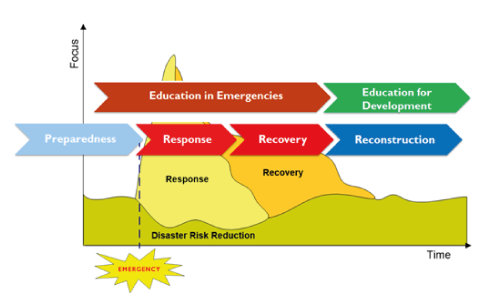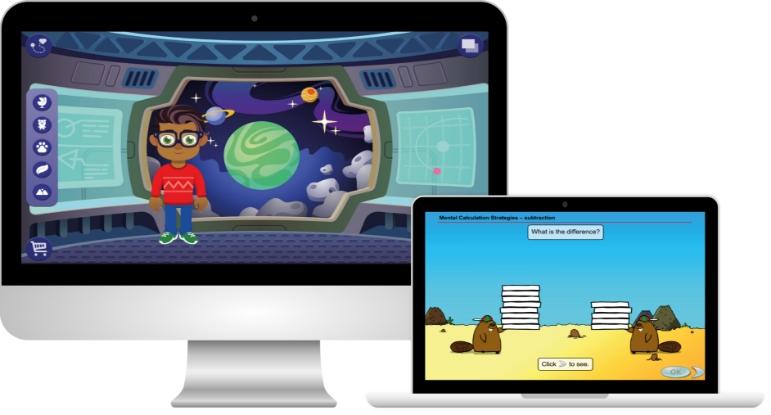Humanitarian language and frameworks can help us to understand education in the time of COVID-19. The response phases in both developed and developing contexts illuminate fundamental educational fault lines and priorities. There is much to learn from humanitarian education approaches to the longer-term recovery phase, and how to address disruption to student learning. But what does it mean to ‘Build Back Better’ in a post-COVID world? The rebuilding of education systems to improve upon the status quo is a laudable aim, yet we must guard against radical overhauls and the naive assumption that technology alone will drive systemic change in the sector.
A response framework
When COVID-19 struck, it was instructive to observe how initial responses played out in different parts of the world. The Education in Emergencies sector (EiE) has a wealth of experience in addressing serious disruption to learning. Unplanned school closures are commonplace in many parts of the world and responses to them are informed by expertly compiled, adaptable global standards. EiE is itself part of a wider and even more established humanitarian ecosystem built on principles, standards and decades of experience – and underpinned by the Humanitarian Imperative.
Broadly speaking, humanitarian responses unfold in definable phases with accompanying priorities. For education, these could be summarised as follows:
1.Initial response: Focus on the psychosocial needs of student and teachers; Restoring basic access to learning (spaces)
2.Recovery: Establishing routines and a sense of normalcy; Increased focus on quality
3.Reconstruction: Reintegration into mainstream; Build preparedness and resilience into system to mitigate future crises; ‘Build Back Better’
(The World Bank articulates these three phases as Coping, Managing continuity and Improving and Accelerating.)

Notably, responses to COVID-19 in the global North began to organise themselves around this humanitarian framing. We’ve seen examples of school trusts directly referencing UNICEF protocols in their closure and reopening plans. Elsewhere, the adoption is simply intuitive. The slogan below pithily rephrases the initial response priorities for education – and chimes no doubt with the pastoral instinct of many educators at the time.

Access & Quality
Access
Humanitarian response frameworks and language can help us all to understand education in the time of COVID-19, and to see what our priorities should be. Working as an EdTech organisation in both developed and developing world contexts has brought fundamental educational fault lines around access and quality to the fore for us during the pandemic. In Kenya and the DRC, for example, we encounter the foundational challenge of access in this early phase. Access to learning is abruptly impeded for the majority of beneficiaries who do not have devices or internet coverage at home. Our responses must adapt to this reality.
In doing so, we find ourselves mirroring the actions of traditional education providers: focusing our energies on teachers, leveraging low-tech solutions such as WhatsApp, and exploring student learning possibilities via similar – and even more rudimentary – access channels. Lessons from the Ebola crisis in fact suggest that “remote teacher learning might be more feasible and impactful than remote child learning.” Other examples of low-tech solutions being well deployed across multiple channels abound, including radio and TV.
Quality
Within this context, quality of learning declines – due to both the pedagogical limitations of low-tech approaches, and to the impact on net learning yield caused by lack of access. In more developed contexts, it is not barriers to access that undermine our COVID-19 responses. Although by no means eliminated, in these contexts teachers have been inundated with access to remote learning platforms and resources since the onset. But access alone is no guarantor of quality learning.
The limitations of quality remote learning are manifold. The shape and priorities of EiE responses, however, may again help us to frame the conversation. The question is not only, ‘How can quality learning occur remotely?’, but also ‘How can teachers replicate (virtually) the routines and normality of the classroom?’
Quality virtual instruction during COVID-19 is thwarted by challenges pertaining to differentiation, scaffolding, aligning online resources with the curriculum and assessing understanding, to name a few. Written instructions become paramount and expose literacy gaps, the volume of content necessarily reduces, and practical explanations are restricted. In some schools, maths lessons have become solely about consolidation. Introducing new concepts takes days, if not weeks, and concrete representations (using manipulatives, for example) cannot be easily recreated via a conferencing tool. Higher attaining learners consequently are not stretched. There are, of course, examples of online platforms – including Maths-Whizz – and creative teachers that seek to address these obstacles. But the former are in short supply, and the burden on the latter to consistently do so is immense and unsustainable.

Normalcy and routine seem a distant oasis. Attempting to replicate the classroom environment remotely is fraught with difficulties. Student engagement is hard to regulate, and individual insights and relationships cannot be recreated in the same way. Added to this, there are well-reported safeguarding issues associated with virtual classroom technologies. There have been some high-profile attempts in the UK to push live remote lessons but educators themselves are quick to resist, for all the reasons stated. While sensible mitigation strategies are being proposed, quality instructional routines – rather than access alone – is the hill upon which our developed world responses stumble.
Reconstruction & Reintegration
Just as the humanitarian response model teaches us what our current educational priorities should be, so we can learn from the humanitarian sector as we cast an eye on the reconstruction phase. Accelerated education, for one, is an established solution in the global South for disrupted learning journeys – in post-conflict or refugee settings, for example. Furthermore, crises represent a critical opportunity to ‘Build Back Better’.

Regardless of the degree of educational access or quality achieved during the outbreak, learning loss will be a given. Mindful of the exacerbating effects of Covid-19 on already vulnerable systems, governments and international actors in developing world contexts are preparing for school returns. It is likely that reintegration to mainstream schooling will include assessing students at the point of return, and offering “accelerated learning that would allow them to catch up”. Accelerated Education (formerly ‘accelerated learning’) Programs (AEPs) are well established in the humanitarian/development sphere, and defined as:
flexible, age-appropriate programmes, run in an accelerated timeframe, which aim to provide access to education for disadvantaged, over-age, out-of-school children and youth – particularly those who missed out on, or had their education interrupted due to poverty, marginalisation, conflict and crisis.
Acceleration is achieved through compression of the curriculum, as well as use of “effective teaching and learning approaches that match [the overage students’] level of cognitive maturity”. In short, AEPs give older students the opportunity to cover the same ground as standard-age learners but at a much faster pace.
Whether formal AEPs are deployed post-COVID, or some kind of transitional ‘catch up’ programme instead, a key challenge arises. In a situation of mass disruption to education, can a low-tech accelerated learning intervention enable acceleration for a whole school? How does this apply, for example, to a school in the UK? Though their operational principles may not all translate to a developed world setting, we can still learn from the fact of AEP deployment at such times as this – and direct our energies at high-tech accelerated alternatives, especially those that dovetail with rather than compress the regular curriculum.
In fact, there are high-tech options available in all contexts. But unless funding exists for this aspiration (not a given due to COVID-induced macroeconomic constraints), we risk doubling down on the existing poverty gap by amplifying the digital divide. Meanwhile, countries in which access to learning technology during the pandemic was not the primary obstacle potentially re-benefit from a tech-enhanced reconstruction phase.
Building Back Better
Where we stand to learn most from humanitarian experiences is in recalibrating our sense of ‘normal’. Crises are in fact an opportunity to improve upon the pre-existing status quo – not least because (in some contexts) “[t]he status quo ante has often been a root cause of the disaster.” Building Back Better is a concept often reserved for the physical rebuilding of educational facilities following a disaster – for example, ensuring that classrooms are not only safer and more robust in the face of future earthquakes, but also constructed to be more amenable to learning than they were previously. Equally, it can apply to the rebuilding – or at least reforming – of educational systems. The Ebola crisis in Liberia ushered in a process of educational reform, which eradicated some negative institutionalised behaviours. Ministers of Education in developing countries today are acutely aware of the need to create systemic resilience post-COVID. There is much talk globally of ‘resetting’, ‘rebooting’ or ’reinventing’ education, perhaps merely with an increased focus on 21st Century skills, but certainly under the banner of “turning recovery into new opportunity”.
Technology will inevitably play a major role in Building Back Better. Teachers’ and students’ experiences of the forced adoption of online learning platforms can inform innovative new ways of delivering curriculum content. Technology can also be intrinsically baked into the system to help it withstand future COVID- aftershocks. Educators around the world are now talking in earnest about blended learning and flipped classroom approaches. The potential of EdTech to revamp assessment norms, and to mitigate the learning loss accumulated during this wave of the pandemic is also well established.
A caveat lurks. Crises are also a blank slate for exploitative disaster capitalism and a Shock Doctrine approach to reconstruction. COVID-19 is no exception. In rebuilding education systems post-COVID, a radical and unwelcome overhaul could be hastily ushered in. Already we see portents of this in the US. If a billionaire-funded, Big Tech-driven reboot of education might emerge from the ‘ground zero’ of COVID-19, then we need to be on our guard. If we are seeing a “distinct warming up to humanless, contactless technology”, then this threatens to become an existential matter. How do we ensure that the technologically-enabled future in education is not merely a proxy for unfettered privatisation, or for the gradual marginalisation of teachers by that technology?

An unshaken commitment to effective EdTech
This moment signifies an opportunity as a sector to reaffirm our principles for effective EdTech. Two post-COVID extremes can be imagined from our considerations above: i) no/low tech learning solutions compounding learning loss upon an increasingly access-deprived developing world and ii) a high-tech system overhaul that ultimately undermines teachers and hastens the privatisation of education. In such a world , the North Star plotting a route between these poles must be our underlying beliefs and values about learning and teaching.
Technology should be used to deliver learning that is relevant, contextualised and engaging.
Technology should be accessible, and leveraged to cater and respond to the immediate educational needs of students.
Most importantly, technology should harmonise with and bolster the professional routines of the classroom teacher.
We find that these principles are unshaken. They are applicable regardless of context. And in marshalling themselves fluently around humanitarian architecture, they elucidate a way forward out of this shared education emergency.

